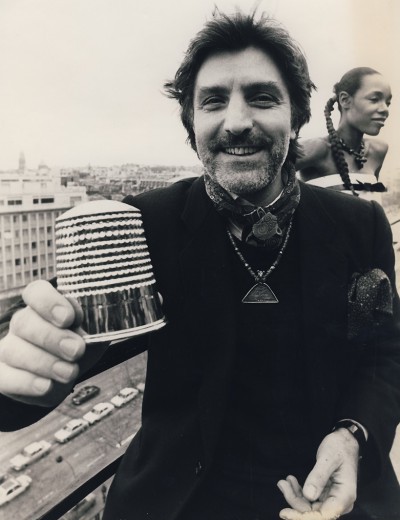
Emanuel Ungaro
About
the designers
Emanuel Ungaro has been one of the most innovative and colourful of today's couturiers.
Emanuel Ungaro was born in 1933, of Italian parents. His father Cosimo Ungaro was a tailor who fled fascism to raise his family in France. Ungaro and his 6 siblings were brought up in a lively country house where food and enjoyment were ever-present and to this day, he says, "I think in French, but I laugh in Italian."
Ungaro moved to Paris in 1955 and worked for Balenciaga for six years and realizing a long dream of becoming a couturier with the Master.
In 1961 he quitting to working for Balenciaga and joined Courreges, designing many of the 60's metal outfits of that house. Courreges was a leading couturier of the 60's and Ungaro's designs were very popular.
In 1965, he opened his own couture business.
1968 Couture in Paris and Rome, had discovered hardware and Ungaro was thoroughly metal minded. He put his models into metal bras. By August he was the leading metal-merchant with body sculptures, and body jewellery.
1970 onwards, Ungaro's work became softer and less rigid. Clothes were made in boldly printed fabrics which have now become his trade-mark. He pays great attention to detail in order to enhance colours, patterns and textures of clothes.
1970 He introduced his first perfume "Diva" The design of the bottle was inspired by one of his draped garments.
During the 70's he introduced long pants, pastel leather coats, drawstring dresses, elasticised shirring on jackets and sensuous fabrics. He inherited exquisite workmanship from his mentor Balenciaga and started to reinforce a silhouette which would be recognized as his own. He obtained his printed fabrics first from Nattier and later from Sonja Knapp. He also showed modernistic geometric renderings of the Kimono, with wide sashes at the waist and necklines slashed to the sash.
During the 80's Emanuel Ungaro progressed to blooming of forms. He liked dresses which impose themselves by the sheer beauty of the volume they created. Colour had a large influence on him and his palette moved across the spectrum.
In the 90's Emanuel Ungaro has maintained his own style, but also moved out into lacy and feminine designs, as well as using animal prints for many dresses, in combination with laces. Several of his outfits used geometric prints as well as intricate embroidery inspired by historic clothes.
1988 At the age of 55, Emanuel Ungaro married Laura Bernabei and they have a daughter. They live near where he was born in Aix-de-Provence, in a converted farmhouse. He has been assisted by his Florentine wife Laura in recent years.
the label
Today, Ungaro has a very flourishing atelier as well as branches all over the world, and his annual turnover is approx. $ 700 million.
In 1996, Ferragamo took over financial control of the Emanuel Ungaro house.
Emanuel Ungaro has continued to design couture for his house, but the Spring 2002 was his last for ready-to-wear. He has passed the torch to a young designer named Gianbattista Valli (born 1967). Valli has worked for Roberto Capucci, Fendi and Krizia before joining Ungaro in 1997. He has been trained by Emanuel Ungaro to take over the design of the house. However, Ungaro has stressed in several interviews that he has no intention of retiring from design of couture. He is still brimming with creative ideas.
At the end of October 2004, Giambattista Valli announced that he would be leaving the house of Ungaro and starting up his own label.
The house of Ungaro announced that the new ready-to-wear designer would be Vincent Darre. Vincent was born in France in 1961 and has worked with Prada, Chloe and Fendi. Since 2002 he was chief designer at Moschino.
The house of Ungaro was owned by the Italian house of Salvatore Ferragamo. However in November 2005, Ferragamo sold Ungaro to a USA California-based venture capitalist Asim Abdullah who made his fortune in computer software and e-commerce. The sale includes garments, mens and womens fragrances and accessories.
After the announcement, Emanuel Ungaro announced his retirement from designing. He has not been actively involved with the designing for the last six months apparently. Plans for the designer at present there, Vincent Darre, have not been discussed.
The Look
His debut was rapturously received, Twiggy and Penelope Tree were photographed by Avedon wearing Ungaro masks. Other popular outfits were leather jackets with hot pants, and pop socks, quilted leather jackets with jockey caps and thigh-high boots, and chain mail dresses with metallic bustiers. Ungaro was the son of a singing tailor, and music has been his inspiration. So his designs are created to an accompaniment of classical music in his salon. This has led to his genius for draping and flowing gowns. His Italian upbringing and love of the country side, has led to his use of a wide range of colours. These are bright, floral, and scintillating. He uses a wide range of fabrics, prints and textures with an impeccable cutting technique. As far as embellishments are concerned, he has in recent years, used more lace and intricate embroidery on his garments.
Who Wears It
Nicole Kidman, Angelina Jolie, Cate Blanchett, Diane Kruger, Lucy Liu, Elizabeth Hurley, Kristin Chenoweth, Uma Thurman, Kylie Minogue, Penelope Cruz, Liz Hurley, Iman Bowie, Callista Flockhart, Emmanuelle Béart, Juliette Binoche, Patricia Kaas, Shiva Rose, Mary J. Blidge, Céline Dion and Kirsten Dunst.